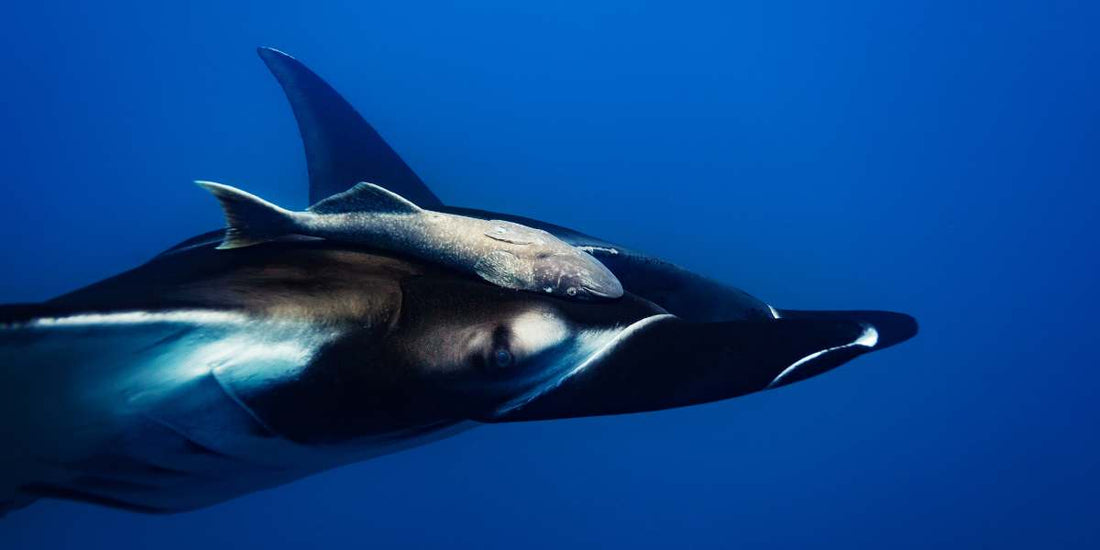
Giant Oceanic Manta Ray: Mobula Birostris
BY NAMUBAKShare
The giant oceanic manta ray ( Mobula birostris ) is the world's largest ray , reaching up to 8 metres (26 ft) in width and weighing over 2 tonnes . Unlike its relative, the reef manta ray ( Mobula alfredi ), this species lives primarily in open ocean waters , and is often found in areas with outcrops, pinnacles and seamounts.

These manta rays filter-feed large quantities of zooplankton such as euphausiids, copepods, and crustacean larvae. They have a unique body structure: two cephalic lobes that channel water toward the mouth and a pattern of spots on the belly that allows them to be individually identified, like a marine fingerprint.
Manta or Stingray? Which is the correct term?
In many places, you'll hear the term "mantas" used to refer to these impressive marine animals. But is there a difference between manta and manta ray ?
The reality is that both terms refer to the same fish , a large ray with a flat body and wing-like fins. However, there are differences in how and when each is used :
Manta ray
It is the most accurate and complete term in Spanish. It is commonly used in scientific, educational, and marine conservation contexts to describe species such as the giant manta ray ( Mobula birostris ) .
Blanket
It's a shortened, informal term that also refers to manta rays. It's common in tourist and everyday language, but can be less clear if context is not provided.
Physical characteristics of the giant manta ray
Physical characteristics of the giant manta ray
Manta rays are recognized by their flat, diamond -shaped bodies, with large pectoral fins that extend like wings. They have ventral gill slits , lateral eyes , and a wide, frontal mouth .

Just in front of the mouth are two mobile structures called cephalic lobes , which extend forward to channel plankton-laden water. This unique trait makes manta rays the only vertebrates with three pairs of functional appendages .
Colors and patterns
Oceanic manta rays come in two main color variants:
- Chevron type: mostly black back with white belly.
- Black type: body almost completely black on both sides.
The pattern of ventral spots is unique to each individual, allowing them to be visually identified, like a kind of marine fingerprint.
In summary, the physical characteristics of the giant manta ray would be:
- Flat, diamond-shaped body
- Elongated pectoral fins that extend like wings
- Eyes on the sides and wide mouth on the front
- Two mobile cephalic lobes (unique among vertebrates)
- Individual identification by unique patterns on the belly
- They can dive up to 600 meters , although they normally swim in waters less than 30 meters deep.
- Estimated maximum speed: 40 km/h
Current status of the giant manta ray population
The global population size of the giant manta ray ( Mobula birostris ) is still unknown , but regional estimates indicate alarmingly low numbers. In most areas studied, with the exception of Ecuador, populations of between 600 and 2,000 individuals are reported, many of them in decline due to fishing pressure .
In contrast, Ecuador is home to the world's largest known population , with over 22,000 giant manta rays , primarily in Machalilla National Park and the Galapagos Marine Reserve.

And in Costa Rica?
In Costa Rica , the giant manta ray is protected by national legislation, although there are no precise estimates of its population in the country. However, it can be observed in key sites such as:
- The Devil's Shoal, Caño Island
- The Big Scare, Bat Islands
- Catalina Islands
- Cocos Island
Despite being protected, the species faces threats such as:
- Unregulated tourism that interferes with their natural behavior
- Interaction with fishing gear, which may cause harm or stress
- Lack of proper management at critical sites
Organizations like The Clean Wave are actively working to protect essential habitats , monitor them through citizen science , and promote responsible diving practices to ensure the conservation of this iconic species.
Life expectancy and reproduction
Giant manta rays have one of the lowest reproductive rates among cartilaginous fish. Females give birth to only one pup every two or three years , after an estimated gestation period of approximately one year. Although individuals have been documented living at least 45 years , much remains unknown about their growth cycle and sexual maturity.
This low fertility rate makes the species extremely vulnerable to any external pressure, making it difficult to recover its populations.

Ecotourism: A Real Way to Protect the Giant Manta Ray
Beyond scientific research and protection laws, one of the most effective tools for conserving the giant manta ray is responsible ecotourism . This form of tourism allows local communities to generate sustainable income while protecting the marine environment.
How does ecotourism help manta rays?
- Reduces fishing pressure : by offering economic alternatives to extractive fishing.
- Promotes environmental education : both for visitors and coastal communities.
- Generate scientific data : thanks to citizen science and photographic records.
- Strengthens local protection : by giving economic value to living marine life.

